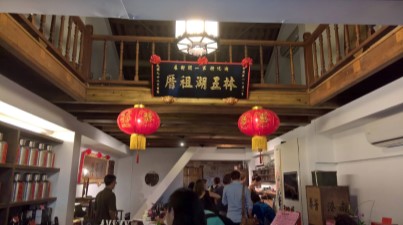

外籍生認識臺北城---大稻埕古蹟行腳
文:工管四 吳宛芸
下午兩點鐘,一場雷雨傾盆而下,大家紛紛躲進宿舍大廳躲雨,然而想要出去一探臺北市的熱情依舊,十五分鐘後,大夥冒雨衝向遊覽車,開始了大稻埕古蹟之旅。遊覽車帶領我們從長興BOT到北門捷運站,一路上Buddy熱情地透過麥克風向外籍生介紹中正紀念堂、誠品北車店等有名地標,更親自來場臺灣小吃中文教學,讓大家的熱情在大雨中更上層樓。
第一站我們來到永樂市場,永樂市場位於大稻埕商圈內,從日治時代起成為全臺最大布料批發零售中心。玲瑯滿目的布料讓大家好奇不已,只見外籍生們東摸摸西瞧瞧,甚是有趣。
第二站我們來到隔壁的霞海城隍廟,在解說員和我們講解歷史後,大家都迫不及待地入內參觀,對臺灣人而言,拜拜、供品、燒紙錢是甚為尋常的習俗,然而對外籍生來說卻是新奇有趣的,部分外籍生計畫下次要好好請城隍爺幫他們施展牽姻緣線的神奇法力。
沿著迪化街走,經過了許多中藥材行、南北貨店及茶行,大家興奮地拿起食材和同伴討論,並分享自己國家的類似食材與烹飪方法的不同處,讓我這本地人也著實大開眼界,增廣不少見聞。
最後一站是日星鑄字廠,琳瑯滿目的中國鉛版字,有些連我也叫不出名堂。日星鑄字廠主要是為活版印刷術的保存,因此每個字都做成像小印章的樣子,然後一格一格的擺放。一開始講解員試著向大家解釋一些字的意義,但最後我們決定教外籍生辨識不同的數字,畢竟對沒學過中文的商學院學生來說,數字是最有連結的。
經過半天的臺北City Tour大家都累了,但從外籍生臉上的笑容可知,大家對這次的行程甚為滿意,他們不僅對中華文化有更一層的認識,同時也對大稻埕的歷史有初步的體悟。學習,在人生中是一個不間段的旅程,希望這次的「古蹟行腳」可以讓他們更了解臺灣。
Taipei City Tour--- Building the future from understanding the pastIt was 2 o’clock in the afternoon, and with that came heavy rains. However, rain could not stop us from our goal of exploring the city of Taipei. Our adventure began on a rain-soaked bus towards the first destination of our adventure.
The first stop on the Taipei tour was the Beimen MRT station area. Our NTU buddies introduced the famous Taipei sites and scenery to our recently arrived exchange students, providing them a Chinese language lesson about Taiwanese food and getting them excited about the rest of the tour. And then we proceeded to the first real stop of the tour, Yongle Market.
Since the Japanese colonial period, Yongle Market has served as the biggest textiles and retail clothing market in Taipei. Our exchange students milled about the market and checked out the various types of clothing on display. From there, we proceeded to the Xia Hai Temple. We explained the various temple worship traditions here in Taiwan, such as praying, burning paper money, and the usage of offerings.
Though these traditions were said to be routine for us, many exchange students found them to be completely new experiences. Walking alone Dihua Street, we passed by many Chinese herbal medicines stores and tea shops. Exchange students shared the different ways in which they use the same ingredients in their own countries and cuisines.
The last stop was the Ri Xing Type Foundry, which is an old production center for Chinese block-print typography. Here, small blocks are milled for use in printing traditional Chinese characters on paper, an art that is rapidly being lost in the age of computing but preserved here for future generations to see. We explained the meaning of different Chinese words to exchange students, as well as symbols for different numbers in Chinese and their intrinsic meanings in Chinese culture.
After a half-day of touring Taipei City, we were all tired, but the smiles on the exchange students’ faces showed that they had enjoyed the experience. This tour was offered as an opportunity to gain a deeper appreciation for Chinese culture as well as the local culture. Learning is said to be an endless journey in life, and we hope that such a tour will be just one of many memorable experiences that exchange students will have during their time in Taiwan.

